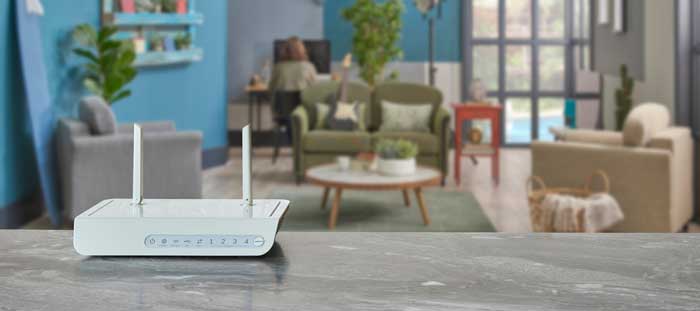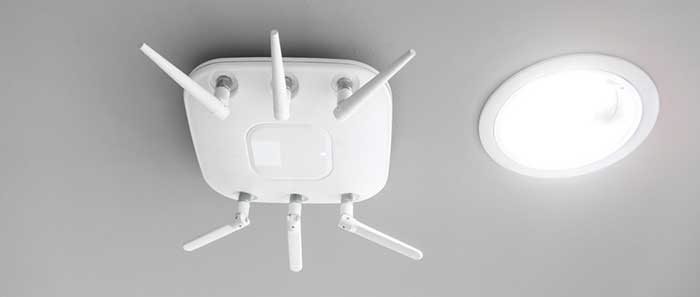If you know anything about the wireless signal, then you’re already aware that it doesn’t just depend on how good your router is. So many things can interfere with the signal. The good news is, you can easily avoid all the obstructions in just a few simple steps!
Thus, in case you’re here to learn whether it should be on the first or second floor and what the perfect location can do for the Wi-Fi signal in your whole house, you’ve come to the right place! We are ready to share all our knowledge on the optimal router placement with you!

CONTENTS
Does The Location Of A Router Matter?
The simple answer is – yes! A wrongly placed router is the main culprit of many people’s poor Wi-Fi signal. Since most modern routers are able to provide a strong connection, a lot of users don’t think about the placement when they first install them. In most cases, everything should work perfectly no matter where you place your wireless router.
However, that doesn’t mean that you shouldn’t think about this aspect at all. Just like any technology equipment, routers can get less effective as they get older. Thus, you shouldn’t be surprised if your signal is much worse now than it used to be.
Recommended reading:
- How to Connect Two Wireless Routers?
- How to Get IP Address of Wireless Router?
- How to Connect Wi-Fi Extender to Smart TV?
In addition, as you’re placing more furniture in the room your device is in or going through renovations, you’ll notice that the quality of your Wi-Fi signal is changing.
That is why you should always take into account your router’s location before deciding on where to put it. Moreover, if you’ve already found a place for the router, it will be pretty easy to move it around once you notice connection issues. We will, of course, help you with all of that today.
What to Consider When Placing Your Wireless Router
Now that you know that a good placement of your W-FI router can do a lot for your signal, especially over time, it’s time to learn where to set it up. We’ll cover a few significant physical signal obstructions and how to get around them.
1. Large Furniture and Appliances
Bigger pieces of furniture, as well as appliances, can present an obstacle to the Wi-Fi signal. While you can’t get rid of your furniture completely, you can find smart ways to fill the room without disrupting the signal.
The main thing you can do is put all of the larger furnishings away from the wireless router. That will prevent the Wi-Fi signals from bouncing off, which can lead to performance problems.
What’s more, you should avoid putting the router near reflective surfaces. The signal will almost certainly bounce off of them and become weaker.
2. Cabinets
If you read the previous point from our article carefully, you already know that storing a router in some kind of cabinet would cause a massive problem with the connection.
Hiding this device will only give it one more object to pass through to get the signal out, which will, of course, make it weaker. That is why your router should always be visible and in the open space.
3. Corners
Corners are another thing that can cause issues with wireless signals. That’s because the routers broadcast these signals in various directions. If you place them near an angled wall, most of these signals would just bounce off and disappear, making the router less effective.
The best thing you can do to prevent this problem is to put the wireless router as close to the middle of the room as possible. In case that’s impossible, you can at least move it off the corner. Sometimes, even a small distance from the angles will do a lot of the quality of the wireless signal.
4. The Floor
We won’t get too specific on how the floor interacts with wireless signals. But let’s just say that it acts as a sponge for them which reduces their abilities. Hence, you should always have some kind of pedestal or a table that will get the wireless router off the floor.
If you’re looking to place the router at the optimum height, you’d want to know that it should always be at least from 5 to 7 feet off the ground. That is around 1.5 m to 2 m.
5. Walls
This one is a no-brainer! Walls can present a considerable obstacle for wireless signals. But, we are aware that not all homeowners prefer open spaces and that there must be walls inside every home.
So, what you can do is avoid brick and concrete at all costs and try not to place a router near walls with insulation. Open doorways and drywall are always the best choices.
Should the Wireless Router be Placed Downstairs or Upstairs?

Here comes the main question of today’s article! The reason why we went through five physical obstacles to your Wi-Fi signal is because we wanted you to get to the answer yourself. That’s mostly due to the fact that the perfect router placement depends on how your house looks like.
Sometimes, in order to get the router away from one obstruction, you’ll have to put it near another. Hence, you must make the decision on the best router location yourself.
But, what we can tell you is that the wireless router should always be in the middle of the house. Therefore, in case your home has two floors, it should either be near the ceiling of the first floor or close to the floor of the second. That is, of course, if you won’t be placing it near other obstructions we mentioned.
In Conclusion
As you can see, the process of finding the perfect location for your wireless router isn’t hard. However, it also isn’t as easy as many homeowners make it seem. That is why many people have issues with a weak Wi-Fi signal.
But, you now know what to keep in mind when you’re setting the router up. As a result, you’ll have a stable wireless connection for years to come!

Hey, I’m David. I’ve been working as a wireless network engineer and a network administrator for 15 years. During my studies, I also worked as an ISP field technician – that’s when I met Jeremy.
I hold a bachelor’s degree in network engineering and a master’s degree in computer science and engineering. I’m also a Cisco-certified service provider.
In my professional career, I worked for router/modem manufacturers and internet providers. I like to think that I’m good at explaining network-related issues in simple terms. That’s exactly what I’m doing on this website – I’m making simple and easy-to-follow guides on how to install, set up, and troubleshoot your networking hardware. I also review new network equipment – modems, gateways, switches, routers, extenders, mesh systems, cables, etc.
My goal is to help regular users with their everyday network issues, educate them, and make them less scared of their equipment. In my articles, you can find tips on what to look for when buying new networking hardware, and how to adjust your network settings to get the most out of your wi-fi.
Since my work is closely related to computers, servers, and other network equipment, I like to spend most of my spare time outdoors. When I want to blow off some steam, I like to ride my bike. I also love hiking and swimming. When I need to calm down and clear my mind, my go-to activity is fishing.
